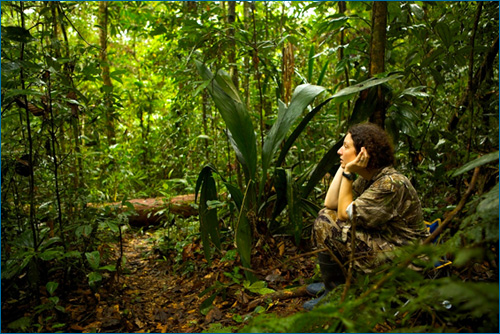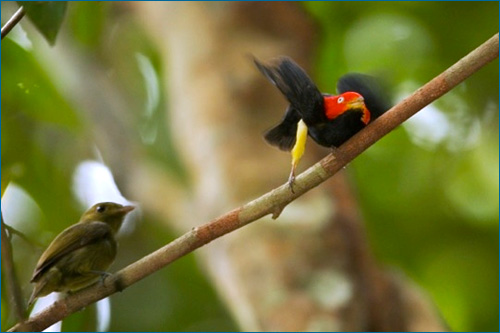Confidence renewed, Kim returned to the field to learn more about the behavior of the Pipra, this time with a high-speed digital camera, technology that had been unavailable just a few years before. She had to go to Costa Rica for another project, so she started with the local red-capped manakin, Pipra mentalis. In Kim’s reading, the bird’s wing sounds had been described as “a single simple klock,” and the bird had normal-looking wings and feathers, so she expected to observe something pretty simple.
Kim is used to spending hours on end, hidden in a blind, waiting for birds to display, but this time, she got lucky. She happened to arrive at her first field site when a female was nearby and, consequently, the males were knocking themselves out to get the female’s attention. Kim recalls, “My biggest memory is that the air was full of wing sounds snapping all over the place — and not just one kind of sound, but a whole bunch of different sounds. It was like I was standing under electric wires. And I just couldn’t shake the feeling that there was a giant hummingbird flying around my head because there was so much whirring noise.” The intense “hummingbird whirr” turned out to be another wing sound of the red-cappeds!

Over the next few days of filming, it became obvious that the mating dance of the red-capped manakin held some intriguing clues to the evolution of the club-winged manakin’s dance. The red-capped manakin didn’t hop back and forth, but did flit in short flights back and forth between perches. And, in addition to a bit of a backwards “running man,” this bird also performed a backwards moonwalk, shimmying across a branch towards the female rump-first. These behaviors were certainly plausible variations on or intermediates of the club-winged manakin’s display. Kim realized that these pieces might fit together into a more complete evolutionary story…

